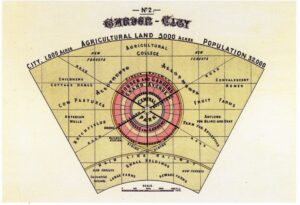Today it is known as the “Japanese Beverley Hills”, but the city of Denenchofu was originally founded on socialistic principles of Ebenezer Howard and realised through the Japanese perspective of developer Eiichi Shibusawa. The city itself is synonymous with words like modern and high quality but how did it reach this star status? Are there aspects of its planning, construction and birth that set it apart from its peer suburbs such as Sakura Shinmachi (Sakura New Town), Meguro Bunkamura (Meguro Cultural Village)?
Within this blog post, I will explore these questions and attempt to answer how the socialistic notions of Howard’s Garden City invariably heightened the success of the city in addition to the instrumental job that Eiichi Shibusawa, played in its creation. Thus, allowing it to reach champion status. I will begin with a dissection and analysis of unique points of interest within Howard’s notion of a Garden City.
“The Garden City is not a suburb, but the antithesis of a suburb: not a mere rural retreat but a more integrated foundation for an effective urban life.”(1)
Howard’s concept of a garden city came into play in 1898 as a socioeconomic planning strategy with the central aim of combatting the ills of the industrialized city(2) . Within this theory, it is clear that Howard and his theory are heavily indebted to a socialist ideology in which the economic viability of the city comes far behind the social and personal fulfilment that its residents should enjoy. His utopian ideas of the Garden City were heavily inspired by Edward Bellamy and his publication ‘Looking Backway (1888)(3). Thus, the garden city was intended to provide an alternative to the suburbs economic and social homogeneity by representing all classes and values(4) .
In the map below, some noteworthy features of Howard’s Garden City are evident.
Firstly, the ratio of city to greenbelt is rather unique; 1,000 acres at the centre for 5,000 of green space. This shows how highly Howard valued parkland space to a low urban population, similarly this is shown in his estimation of a population of 32,000. Historians can also take note of the concentric circles and wedges that form an economic arrangement between producer and consumer: cow pastures, fruit farms, brickfields and asylums/homes show a balance, rather than an overwhelming commercial city.

Figure 1: Ebenezer Howard, diagram of the garden city with central park and rural belt. From Garden Cities of To-Morrow (1898)
Historian Ken Oshima makes it clear that although Denenchofu’s founders aimed to create a garden suburb as per Howard’s vision, it needed to be adapted to Japan. In many ways, what secured the success of Denenchofu was Shibusawa’s philanthropic intentions and concurrence that the development should not driven by economic forces. Thus, paralleling Howard’s social spirit and civic activism(5). Instead of the city being planned to depend on the economic interests of the land companies, lending institutions, or railways companies, it was dependent on a non-profit development company headed by Shibusawa. It was certainly a risk not to build a city based on its potential economic output, but that’s what made Denenchofu unique.
Shibusawa used his highly regarded reputation to raise capital and eventually support for the development. Moreover, Denenfochu’s success could also be attributed, at least in small weight to bursting population of Tokyo and the natural disasters occurring from 1900-1920s that increased the demand for housing outside the city of Tokyo. Nevertheless, the significance of the design of the city should not be overlooked: the coherent street pattern, and hybridization of Western-Japanese style gave the city a sense of urbanity without feeling like a foreign imposed model.
One may argue that Shibusawa did work against Howard’s vision in some ways. For instance: he sold plots of land rather than it being owned communally, in addition, it was less a mix of classes than a neighbourhood for the rising middle class. By 5th May 1928, the Denentoshi Corporation sold all land parcels, and the corporation slowly abandoned its idealistic values for more capitalistic ones(6). Howard’s original concept of an anti-suburb with a degree of self-sufficiency slowly transformed into an oasis of a capitalist society. Its initial success is what caused the demand to grow, which consequently caused the price of land in the city to rise – and so capitalism sang its song. Nevertheless, we can attribute Howard’s ideas to the early success of Denenfochu as a garden city; and Shibusawa’s success as a developer for making it an oasis that capitalism then transformed into the less pure form of a ’garden city’. At the very least, we can reflect on Denenchofu as an actualized fusion of East and West that is still relevant today.
(1) Lewis Mumford, “The Garden City Idea and Modern Planning,” in Ebeneezer Howard, Garden Cities of To-Morrow (London, 1945) p.35
(2) Ken Tadashi Oshima, Denenchofu: Building the Garden City in Japan p.140
(3) http://architectureandurbanism.blogspot.com/2010/10/ebenezer-howard-garden-cities-of-to.html
(4) Ken Tadashi Oshima, Denenchofu: Building the Garden City in Japan p.141
(5)Christensen, American Garden City, p.140.
(6) Ken Tadashi Oshima, Denenchofu: Building the Garden City in Japan p.149